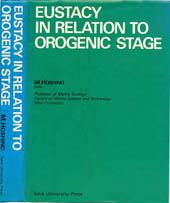|
Michihei Hoshino Tokai University Press, 1975, $ 40  The author contends that there has been a rise of some 2,000 m in sea leve1. This rise is conceived as having taken place over a relatively short period of time, perhaps no more than one thousandth of the five billion Year history of the earth. The latest stage in the development of the earth, the one in which we are now living, is one which has seen tremendous geological changes. The author contends that there has been a rise of some 2,000 m in sea leve1. This rise is conceived as having taken place over a relatively short period of time, perhaps no more than one thousandth of the five billion Year history of the earth. The latest stage in the development of the earth, the one in which we are now living, is one which has seen tremendous geological changes.Enormous mountain ranges were thrust up by the pressure upon the crust of material orignating within the mantle. This subjected the crust to bodily upheaval, and the effect of the mountain ranges which resulted was to disturb the atmosphere so violently as to cause the development of glaciers. Vast amounts of terrestrial heat energy were released from the sea bottom, causing first convection currents, and in turn, strong oceanic currents. The crust upheaval took place not only under land, but also on the ocean floor. While the amount of the upheaval varied in absolute size from place to place, it is assumed that the overall effect was an expansion of the earth. Upheaved ocean floors caused increased sea levels which submerged land that had undergone a relatively smaller upheavaL This land then formed new sea floors. The trenches we now see originated from the depression between two sections of crust whhich both underwent upheaval. This hypothesis gives a satisfactory account of the origins of submarine canyons and coral reefs, phenomena which have long fascinated - and baffled - marine geologists, As a corollary, it is obvious that such geological changes must have had climactic effects on living species, particularly upon their subsequent evolution and distribution throughout the earth. The author's highly original hypothesis is germinal for the future not only of geology and geophysics, but also for oceanography and biology.  Hoshino, Michihei D.Sc. Professor of Marine Geology Faculty of Marine Science and Technology of Tokai University He was born of farming stock in 1923 at the foot of the Akagi Volcano on the upper reaches of the Tome River, in central Honshu. In his youth he loved literature, particularly pcety, and felt the attraction of the mountains very strongly. His interests centered in mountain topography, and his first intention was to make this his field of study. However, impressed by the words of his middle-school teacher, that topography is based upon geology, he altered his course from topography to geology. In 1949, he graduated from the Tokyo University of Literature and Science. His graduation thesis had as its subject the moIIuscan fossils of the Neogene Tertiary of his native country. After graduation, he took up employment in the Japanese Hydrographic Office upon the recommendation of the Chief Hydrographer, Dr. K. Suda, who comes from the same district. Here, he studied the sediments on the continental shelf around the Japanese lslands, and every other Sunday he engaged in field work with his friends, surveying the Quaternary system in the suburbs of Tokyo. ln 1958 he received his doctorate (D.Sc.) from his Alma Mater. In 1961 he presented the hypothesis of a large scale rise in sea level since the late Miocene, and attributed it to the expansion of the earth. From that time on, until 1974, he pursued this theme and gathered his results into this book. ln 1964, he transferred to Tokai University from the Hydrographic Office. His other published scientific works in Japanese include "The Shelf Sediments in the Adjacent Seas of Japan (1958),""The Pacific Ocean (1962)," "Continental Slope (ln Deep-Sea Geology. 1970)." "Continental Shelf (in Shallow-Sea Geology, 1972)." In Addition to these, he has published popular books including "The World Under the Sea (1964)," and "Science of the Pacific Ocean (1969)." He has also translated Hans Petterson's "Westward Ho with the Albatross (1957)" and "Tne Ocean Floor (1959)" into Japanese. At present, he is interested in petroleum-bearing rocks, guyot, and granite. Each of these topics has a bearing on the eustacy of the geocynclinal stage. (This is written in 1975) |